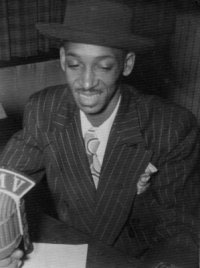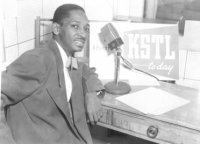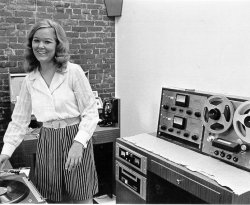Radio Articles
Radio Legend Don Pietromonaco Dies
by Larry Hoffman
The passing of legendary St. Louis radio personality Don Pietromonaco was recognized by various media outlets in St. Louis including a detailed obituary in the St. Louis Post-Dispatch.
Pietromonaco, who was perhaps the most theatrically gifted broadcast talent in the history of St. Louis radio, was remembered by a retrospective segment on KSDK-TV and by KLOU jock Mike Jeffries. Jeffries commented on the Post article, noting that KLOU listeners who lived here during the heyday of Johnny Rabbitt on KXOK, 1964 – 1968, surely remembered Pietromonaco and his antics.
Former KXOK employees and associates of Pietromonaco offered tributes in interviews conducted by the St. Louis Journalism Review. Delcia Corlew, former owner of the Delcia Agency and spokeswoman for Famous Barr in the mid-60s as Delcia Devon, told SJR, “I was really saddened to hear about it,” after which she offered fond memories of this dynamo of a disc jockey and his remarkable radio ventriloquism.
Voiceover artist and former KXOK News Director Robert R. Lynn recounted the hilarity of one Saturday morning during a Johnny Rabbitt remote broadcast from the downtown Stix, Baer & Fuller store. Lynn agreed to appear as Rabbitt sidekick Bruno J. Grunion and arrived in full attire, including several stick-on pimples. During the bit he had some sort of cake thrown in his face at which point a few of the pimples transferred to his dessert. After he cleaned up, somehow a couple of fake pimples ended up in a piece of cake being served to the crowd.
An astute kid confronted Lynn and said, “Hey, you’re not Bruno, and one of your zits is in my cake!”
SJR was fortunate to receive a call from former Storz-era KXOK Station Operations Manager Bud Connell who is currently a California-based writer, director and producer of “anything except full-length motion pictures.” Connell’s company is known as BCTV.
Connell went on record with the history of the Johnny Rabbitt name and its eventual stellar achievements for St. Louis’ premier rock ‘n’ roll radio station during the ‘60s.
“Johnny Rabbitt is my invention,” Connell told SJR. “The roots of the name and the character began in Miami in the late winter of 1961 with an Easter promotion which used a character named ‘Daddy Rabbitt.’ Eventually we borrowed a first name from Johnny Carson, grafting it onto what we already had, and Johnny Rabbitt was born. I originally voiced the character on WFUN in Miami. Then, when I moved to KXOK in July 1961, I was given free reign under General Manager Chet Thomas to build KXOK into what it eventually became. I hired Ron Elz as the first person to use the name Johnny Rabbitt on the air at KXOK. He was adequate, but he had some serious shortcomings.”
Connell went on to say that he continued to improve KXOK, and by mid-1962, the station was #1 in the Pulse ratings survey. “Don Pietromonaco came along after Elz was no longer with the station and became the definitive Johnny Rabbitt – he became the figure, the image – he fulfilled the potential of the character. Pietromonaco lived the part 24 hours a day and rose to the occasion due to his inherent sense of show business.”
Connell saw KXOK through its best years, indeed the best of Pietromonaco’s career, according to an interview in SJR in 1996. Pietromonaco said, “By the time I left KXOK in the summer of 1968, the owner, Robert H. Storz, who had no concept of broadcast programming other than to make money and imitate others…began to downplay personalities in favor of turning the station into a jukebox. That was the end of KXOK as we knew it during those unforgettable years.”
Pietromonaco continued as a disc jockey in Phoenix after his departure from St. Louis, winning numerous industry awards including Billboard Magazine’s Personality of the Year in the early ‘70s. He had returned to his native California during the early ‘80s, teaching broadcasting and operating a voiceover studio at the Don Martin School of Radio/TV in Hollywood, according to former associate Darrell Wayne.
“What energy this man had, punctuated by old radio stories from his days in St. Louis,” Wayne told SJR.
(Reprinted with permission of the St. Louis Journalism Review. Originally published 5/97)


